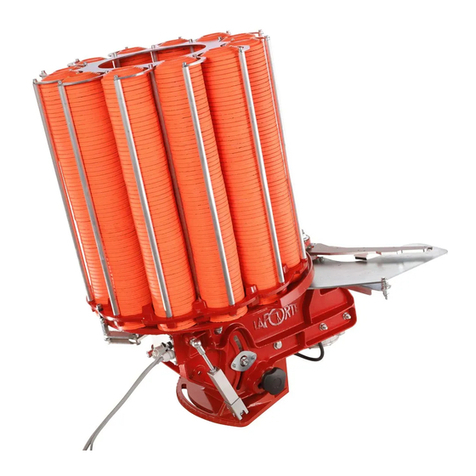
-Le bras de lancement est bloqué par 2 cibles, ou par
des pigeons cassés. ATTENTION : Le bras de
lancement appuie trop FORTEMENT sur les
cibles. Désarmer la machine en utilisant le
"désarmement manuel", soyez très PRUDENT, car le
bras de lancement va se relâcher TRES vite. La (es)
cible(s) sur la plaque de lancement vont probablement
voler en éclats dans TOUTES les directions.
-Le bras de lancement est tordu ou cassé et coincé
contre une partie de la machine, c.à.d. une vis ou la
base du barillet. CECI EST TRES DANGEREUX!
Comme vous ne pouvez pas désarmer la machine, le
bras doit être enlevé… Appeler LAPORTE.
4. LE BRAS DE LANCEMENT NE
S’ARRETE PAS ET LANCE DES CIBLES.
-Le micro-contact d’armement est cassé ou déréglé, et
oblige le moteur d’armement à fonctionner en continu.
-Le relais est défectueux (il reste collé) DANGER LA
MACHINE CONTINUE A LANCER DES
PLATEAUX MEME EN POSITION OFF. Il faut
déconnecter la machine de la source d’alimentation.
-Le bouton "PULL" est bloqué ou le câble est abîmé.
-Le bouton de transmission de l’émetteur radio
commande en position est continuellement enclenché
(ex dans la boite à outils, un tiroir de bureau, la poche,
un étui à fusils, etc.). Vérifier en débranchant le
récepteur de la télécommande depuis le coffret
électronique.
-Un autre émetteur radio pourrait être réglé sur la
même fréquence que le récepteur et déclencherait la
machine. Vérifier en débranchant le récepteur de la
radio-commande du coffret électronique.
-Le circuit électronique du boîtier de commande peut
avoir “grillé".
5. BRUITS ANORMAUX
-Vérifier le serrage des boulons.
-Le ressort d’armement est détendu et les spires se
touchent entre elles : il est impératif lorsque le
ressort est détendu à fond, que les spires ne se
touchent pas. Dans le cas contraire, cela pourrait
causer la rupture du corps principal!
-Anti-retour détérioré ou cassé.
-Le bras de lancement est tordu et frotte sous la
plaque SB (Support Barillet) ou sur la plaque de
lancement.
-La plaque de lancement peut être desserrée.
6. LES CIBLES CASSENT AU
LANCEMENT
-Les cibles étaient cassées avant le chargement.
-Les cibles se sont cassées pendant le chargement.
-Cibles mélangées (différents diamètres c.à.d. 107-
108-110 mm).
-The throwing arm is blocked by two clays or by
fragmented clays. WARNING: At this time the
throwing arm will be pressing against the targets
with TREMENDOUS PRESSURE. When
uncocking the trap using “Manually Uncocking”, be
EXTREMELY CAUTIOUS, as the throwing arm will
release VERY fast.
The target(s) on the throwing plate will most probably
shatter throwing target fragments in all directions.
-The throwing arm is bent or broken and
subsequently jammed against some part of the
trap, e.g. the throwing plate, the magazine base.
THIS IS A VERY DANGEROUS CONDITION!
As you cannot “re-cock” the machine. The arm
will have to be removed…. Call LAPORTE for
help.
4. THE THROWING ARM DOES NOT STOP
DECOCKING AND THROWING TARGETS.
-The cocking micro-switch is broken or out of
adjustment, and causes the cocking motor to run
continually.
-The relay is defective and sticks. WARNING: THE
MACHINE CONTINUES TO THROW CLAYS
EVEN WHEN SWITCHED OFF.
It is imperative to disconnect the power supply.
-The “PULL” button is stuck, or the cable is damaged.
-The button on the radio remote control is continually
pressed (e.g. in a tool box, office drawer, pocket etc).
Check by carefully disconnecting the receiver of the
radio remote from the electronic control box.
-Another radio transmitter could be adjusted to the
same frequency as the receiver and operate the
machine. Check by disconnecting the receiver of the
radio remote from the electronic control box.
5. ABNORMAL NOISES
-Check all bolts for tightness.
-The mainspring does not have sufficient tension on it,
and the coils are touching each other: it is imperative
that when the spring is at minimum tension, the
coils do not touch. If they do, this could break the
main body.
-The one way bearing is worn out or damaged.
-The throwing arm is bent and scrapes on the
underside of the magazine support base plate or on the
throwing plate.
-The throwing plate is loose.
6. THE TARGETS BREAK IMMEDIATELY
WHEN FIRING
-The targets were damaged prior to loading.
-The targets were damaged during loading.
-Mixed targets (different diameters in it stack i.e. 107-
108-110mm)
CHAP 1 PAGE 4.1




























